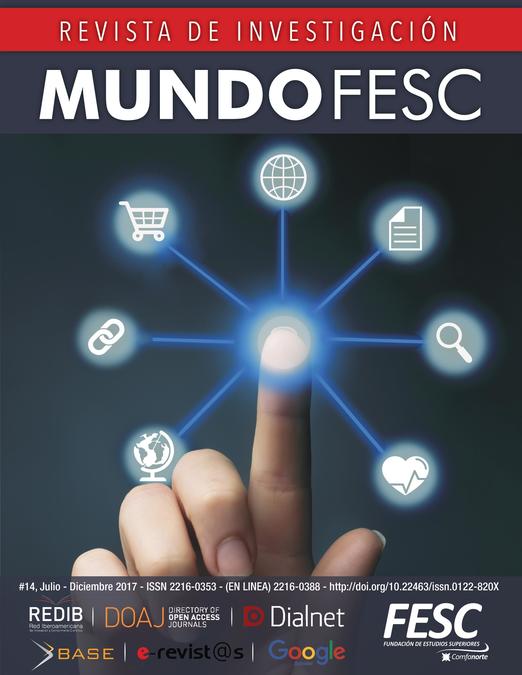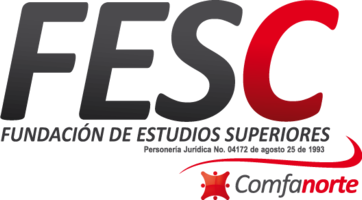Herramienta computacional de uso pedagógico para el modelamiento de los transistores de unión bipolar BJT
DOI:
https://doi.org/10.61799/2216-0388.143Palabras clave:
Herramienta computacional, transistor de unión bipolar, modelamiento, proceso de aprendizaje, apoyo docente, Matlab.Resumen
Resumen
El mundo actual vive constantes avances en materia tecnológica, adquisición y actualización de la información; por lo cual se evidencia la necesidad de adquirir nuevos conocimientos. La educación actual procura hallar a través de los medios tecnológicos el camino para hacer más asequible el entendimiento. El objetivo del presente trabajo de investigación es diseñar una herramienta computacional educativa correspondiente a la asignatura de Electrónica I orientada a los estudiantes de sexto semestre de la carrera de Ingeniería Electrónica de la Universidad Francisco de Paula Santander. Dicha aplicación de tipo educativo presenta una metodología basada en los análisis del entorno, diseño de las diversas configuraciones del Transistor BJT, modelados matemáticos, desarrollo e implementación de la herramienta, prueba piloto y empleo en el aula de clase. Como resultado se obtuvo una herramienta computacional diseñada en Matlab (“MATriz LABoratory”), la cual permite diseñar y calcular los diversos parámetros utilizados en las configuraciones de operación de los transistores bipolares de unión (Bipolar Junction Transistor, BJT); como lo son el circuito rectificador media onda y onda completa con diodos (conducen corriente en el sentido directo), polarización fija y por división de voltaje y las configuraciones de emisor común, colector común y base común, buscando con ello servir de apoyo a las temáticas vistas en el aula de clase y en la ejecución de las prácticas de laboratorio, obteniendo de esta forma un aprendizaje más interactivo y que facilita el refuerzo de los conceptos adquiridos en la asignatura.
Palabras Clave: Herramienta computacional, transistor de unión bipolar, modelamiento, proceso de aprendizaje, apoyo docente, Matlab.
Resumo
O mundo atual é avanços constantes em tecnologia, aquisição e actualização da informação; por isso a necessidade de adquirir novos conhecimentos é evidente. A educação atual se esforça para encontrar através de meios tecnológicos a forma mais acessível à compreensão. O objetivo desta pesquisa é a concepção de uma ferramenta de software educacional correspondente ao objecto de estudantes orientados I Eletrônico de sexto semestre da carreira de Engenharia Eletrônica pela Universidade Francisco de Paula Santander. Tal aplicação de natureza educacional apresenta uma metodologia baseada na análise do ambiente, design das várias configurações de BJT Transistor, modelagem matemática, desenvolvimento e implementação da ferramenta, piloto e do emprego na sala de aula. Como resultado obteve-se uma ferramenta computacional concebido em Matlab ( “Matrix Laboratório”), que permite a concepção e calcular os vários parâmetros utilizados em configurações operacionais de transistores bipolares de ligação (Junção Bipolar Transistor, BJT); como eles são o circuito rectificador de meia-onda e o diodo de onda completa (conduzir a corrente em sentido directo), polarização fixa e divisão de voltagem e configurações de emissor comum, colector comum e uma base comum, procurando assim proporcionar suporte para o vistas temáticas em sala de aula e na execução de práticas de laboratório, obtendo assim uma aprendizagem mais interativo e facilitar o reforço dos conceitos adquiridos no assunto.
Palavras-chave: ferramenta computacional, transistor de junção bipolar, modelagem, processo de aprendizagem, apoio ao ensino, Matlab.
Descargas
Referencias
Artopoulos, A., & Kozak, D. (2011). estilos de adopción de tecnología en la educación latinoamericana. Revista iberoamericana de ciencia tecnologia y sociedad. Obtenido de http://revistacts.net/files/Artopoulos(2).pdf
Ararat , E. M. (Enero - Junio de 2017). Análisis del uso de las redes sociales en los estudiantes. Mundo Fesc(13), 106-114.
Barragan, D. (2017). Matpic. Recuperado de: Matpic: http://www.matpic.com/esp/matlab/interfaz_grafica.html
Cabrera, J., Sanchez, I. & Rojas, F. (s.f.). Uso de objetos virtuales de aprendizaje OVAS como estrategia de. Asociacion Colombiana de Facultdes de Ingeneiria. Recuperado de: https://www.educacioneningenieria.org/index.php/edi/article/view/602/291
Cardona, H., Burgos, M., González, J., Isaac, I. & López, G. (Junio de 2012). Aplicación en Matlab para la programación del despacho Hidrotérmico. Investigaciones aplicadas, 6(2),42-53. Recuperado de: http://revistas.upb.edu.co/index.pvhp/investigacionesaplicad
Charre, S., Alcala, J., Lopez, N., & Duran, M. (2014). Sistema Didáctico de Control de Presión,. Formación Universitaria, 7(5), 33-40. DOI: https://doi.org/10.4067/S0718-50062014000500005
Gamarra, M., Bertel , F. & Velásquez, J. (2016). Herramienta de Software para el Aprendizaje de Sistemas Difusos en un Curso de Control Digital. Formación Universitaria, 9(4), 33-40. DOI: https://doi.org/10.4067/S0718-50062016000400005
Lopez, C. (2009). Perspectiva de los alumnos por el uso del Blog en el aula. Revista Internacional de Educación en Ingenieria, 2(1). 19-29.
López, J., & Arango, J. (Enero - Junio de 2015). Algoritmo genético para reducir el makespan en un flowshop híbrido flexible con máquinas paralelas no relacionadas y tiempos de alistamiento dependientes de la secuencia. (U. Libre, Ed.) Entramado, II(1).
Lorandi, A., Saba, G., Hernández S. & Guevara, E. (2011). Los Laboratorios Virtuales y Laboratorios Remotos en la Enseñanza de
la Ingeniería. Revista internacional devveducación en Ingenieria, 4. 24-30
Marista, U. (Agosto de 2014). Proceso de enseñanza aprendizaje. Recuperado de: Universidad Marista de Mérida. Recuperado de: http://www.marista.edu.mx/p/6/procesode-ensenanza-aprendizaje
J Mendoza (11 de septiembre de 2007). Polarización del bjt: polarización fija [Mensaje en un blog]. Recuperado de: http://jorgemendozapua. blogspot.com.co/2007/09/polarizacion-del-bjt.html
Monbrun, O. (s.f.). Automatización, c.a. Recuperado de: http://www.eldish.net/hp/automat/matlab.htm
Morales, A. (2009). Innovación social: un ámbito de interés para los servicios sociales. EKAINA. Obtenido de http://www.zerbitzuan.net/
documentos/zerbitzuan/12.pdf
Pérez , O., & Sánchez , J. (2018). Impacto pedagógico del avance tecnológico de las herramientas en el diseño de sistemas digitales. Revista Internacional de Educación en Ingeniería, 10(1). 4-15.
Plata, R. (2008). MatLab & Redes Neuronales. Revistas Bolivianas(1), 96-102.
Porras, H., Sanchez, O., Galvis, J. a., Jaimes, N. A., & Castañeda, K. (2015). Tecnologías “Building Information Modeling” en la elaboración de presupuestos de construcción de estructuras en concreto. (U. Libre, Ed.) Entramado, II(1), 230 - 249. DOI: https://doi.org/10.18041/entramado.2015v11n1.21116
Rosales, G. (2010). Uso de Matlab para la enseñanza y aprendizaje de la solución de las ecuaciones lineales con enfoque geométrico
para ingeniería. Journal of Engineering and Education, 6(10), 59-68.
Salao, J. (2009). Estudio de las técnicas de inteligencia artificial mediante el apoyo de un software educativo. Riobamba: Trabajo fin de
carrera, Facultad de Informática y Electrónica, Escuela Superior Politécnica de Chimborazo.
Sánchez, K. & Guerrero A. (2013). Entorno visual de aprendizaje para las configuraciones de los transistores BJT como amplificadores.
Universidad Cooperativa de Colombia, 11(20)79-86
Semenov, A. (1996). Las tecnologías de la información y la comunicación en la enseñanza. Moscú: Instituto de Educación
Abierta de Moscú.
Torres, Y. & Macias, N. (2009). Software Educativo como apoyo en el proceso de enseñanza aprendizaje del método de reducción en la
resolución de ecuaciones lineales. (Trabajo de pregrado).Universidad de Los Andes.
Vásquez, , R., Posada, N. & Castrillon, F. (2015). Desarrollo de una Estación Experimental Multipropósito para la Enseñanza en Control DOI: https://doi.org/10.4067/S0718-50062015000500004
de Procesos. Formación Universitaria, 8(5),25-34.
Villafuerte , R., Villafuerte, R., Mejia, E. & Medina, J. (2012). Métodos numéricos en el proceso. Revista Internacional de la Educación en Ingeniería, 5(1), 45-53.
Wang, L. & Liu, Z. (2008). Comprehensive Mechanism and Structure-Sensitivity of Ethanol Oxidation on Platinum: New Transition-State Searching Method for Resolving the Complex Reaction Network. Journal of the american chemical society. DOI: https://doi.org/10.1021/ja801648h
Descargas
Publicado
Número
Sección
Licencia
Derechos de autor 2018 Mundo FESC

Esta obra está bajo una licencia internacional Creative Commons Atribución-NoComercial 4.0.






